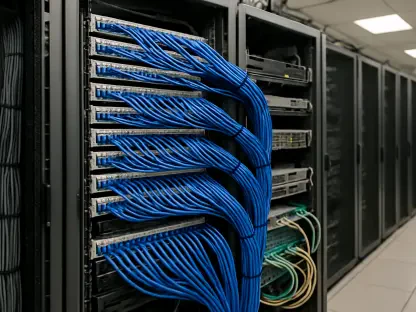The ARRI Network Interface Adapter NIA-1 has emerged as a vital component in advancing camera and lens control via Ethernet, marking a significant leap in digital cinematography and live productions. By seamlessly blending traditional LBUS control systems with modern IP network workflows, ARRI introduces a groundbreaking evolution in camera functionality. This shift heralds not only enhanced capabilities for ARRI’s Electronic Control System (ECS) but also greater compatibility with third-party products, substantially broadening the scope and utility of current technology in diverse production environments.
Revolutionizing Camera Control Infrastructure
Bridging Traditional and IP-Based Systems
At the core of the ARRI NIA-1 lies its role as a vital intermediary between classic LBUS-based configurations and contemporary IP networks, thereby redefining the control architecture for cameras and lenses. This technological breakthrough enhances the scalability and remote control potential of ARRI’s ECS across multiple devices with Ethernet connectivity. By facilitating nearly latency-free operations over an IP network, the NIA-1 offers a significant advantage to both cine and live broadcast sectors, allowing devices like the Hi-5 hand unit to perform with remarkable efficiency. Furthermore, the adapter’s capability extends beyond ARRI’s native devices, ensuring seamless integration and control even with third-party cameras.
With its compact design, the NIA-1 incorporates robust features such as LBUS, Ethernet, and USB-C connectivity, complemented by an intuitive touch screen displaying connector statuses. The device’s user-friendly interface is further supported by remote management options via a web interface accessible from any network device. This flexibility underscores the NIA-1’s adaptability, offering users varied options in operational settings while maintaining comprehensive control over connected devices. The ease of managing network setups through automatic or manual configurations reinforces its value, enabling swift synchronization of network components for streamlined, efficient workflows.
Expanding Utility Beyond Traditional Applications
The NIA-1’s innovation extends beyond established filming applications, venturing into new realms such as live broadcasting and multicamera setups. By supporting ARRI’s ALEXA 35 Live Multicam System, the device elevates the production standard, utilizing a secondary Ethernet tunnel to facilitate advanced control over vast distances. This setup is further amplified when paired with components like ARRI’s LPS-1 system, delivering precise, real-time adjustments over extended ranges. Compatibility with equipment such as the 360 EVO stabilized remote head highlights the NIA-1’s versatility, offering a streamlined plug-and-play solution with just an Ethernet or fiber connection.
This enhanced connectivity also revolutionizes operations for professionals like DITs and focus pullers, promoting remote management of settings over IP networks. Whether for simple setups linked by Ethernet cables or more complex arrangements using fiber optics for longer spans, the NIA-1 proves its merit. Such configurations are particularly beneficial in challenging scenarios, including underwater filming environments, where cameras equipped with NIA-1 maintain reliable communication with surface units, thereby enhancing operational efficiency and effectiveness in diverse filming conditions.
Advancing Third-Party Integration Capabilities
Facilitating Comprehensive Camera Control
One of the NIA-1’s landmark features is its capability to streamline operations involving third-party cameras within ARRI’s ecosystem, eliminating the need for specialized cables across different camera brands. This integration substantially amplifies operational efficiency across varied productions, enabling directors and crews to handle camera functionalities purely through direct network integration. Consequently, the NIA-1 offers a comprehensive enhancement to the use of ARRI ACS tools, simplifying communication pathways while optimizing the utility of existing equipment.
Crucial to this process is the NIA-1’s interaction with the Rotary Release Adapter RRA-1, which simplifies installation through a quick-release dovetail mechanism and robust metal construction. This straightforward mounting solution, combined with permanent licensing options for specific camera models like Blackmagic URSA Cine and Sony Burano, broadens its applicability. Notably, the anticipated opening of compatibility with the Sony Venice camera, facilitated by an upcoming NIA-1 software update, underscores ARRI’s commitment to expanding its technology’s reach, particularly with Sony’s Camera Control License for Hi-5, thus enabling broader control capabilities among its devices.
Enabling Robust Multi-Camera Synchronization
In environments where precision and synchronization are paramount, such as VFX workflows and 3D rigs, the NIA-1 demonstrates its versatility and reliability. The adapter ensures synchronized control over varied lens motors and camera configurations, adapting to multiple lens types and focal lengths without compromising performance. This technical sophistication enriches ARRI’s ecosystem by allowing seamless integration of ARRI lens motor and camera control capabilities into third-party devices over IP networks, facilitating operations across a broad spectrum of production types.
To drive these advanced capabilities, ARRI actively seeks partnerships with third-party vendors, promoting the inclusion of ARRI’s ECS components in external hardware and software solutions. This strategic expansion aims to encompass various areas, including motion control systems and virtual production platforms, signifying ARRI’s commitment to a cooperative industry landscape. By nurturing cross-platform interchangeability, ARRI not only fosters innovation but also enhances collective production efficiency, paving the way for future advancements across the cinematic and broadcast domains.
Prospects for Future Integration and Expansion
Anticipating Industry Transformations
The NIA-1 signifies a fundamental shift in digitally augmenting camera and lens operations, representing a pivotal step forward in cinema and broadcast technology. By incorporating Ethernet capabilities into established ARRI systems, the NIA-1 paves the way for a transformative era in camera control. It positions ARRI at the forefront of technological innovation, uniting traditional cinematic practices with cutting-edge IP network solutions. As a result, it invites filmmakers and broadcasters to explore new creative horizons using advanced digital tools.
Moreover, the launch of the NIA-1 prompts industry stakeholders to prepare for future developments where interoperability and high-speed data management are essential components. The device not only enhances current capabilities but also sets the stage for upcoming innovations in digital filmmaking and broadcasting. As new uses and configurations emerge, the NIA-1’s adaptability ensures it remains a central hub for modernized camera control, capable of addressing myriad production needs.
A New Standard in Camera Control
The ARRI Network Interface Adapter NIA-1 represents a pivotal advancement in the realm of digital cinematography and live productions, focusing on the integration of camera and lens controls via Ethernet. This innovative device bridges the gap between conventional LBUS control systems and cutting-edge IP network workflows, fostering a significant transformation in camera functionality. This transition not only augments the capabilities of ARRI’s Electronic Control System (ECS) but also enhances compatibility with third-party products. By doing so, it effectively expands the range and utility of technological applications across various production environments. The introduction of the NIA-1 enables filmmakers and production teams to optimize their workflows, streamline operations, and achieve unprecedented levels of control and precision in their projects. This evolution solidifies ARRI’s position at the forefront of the industry, underscoring their commitment to driving technological progress while navigating the increasingly complex landscape of modern digital production.









